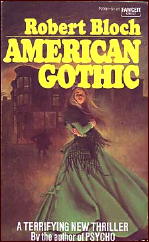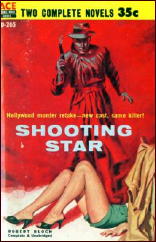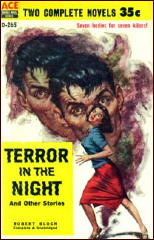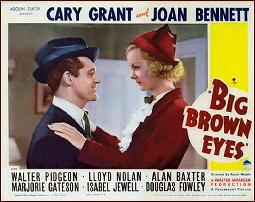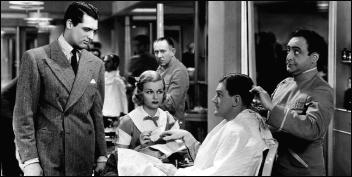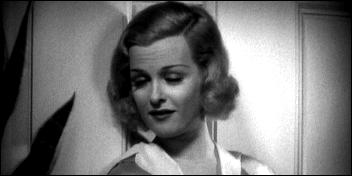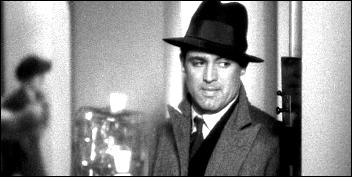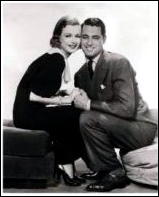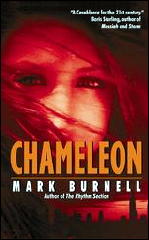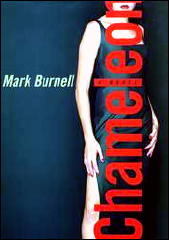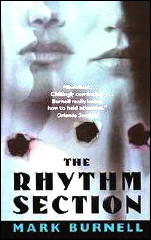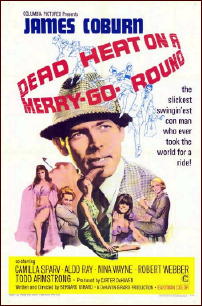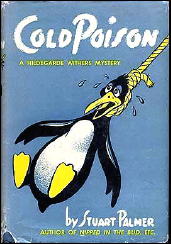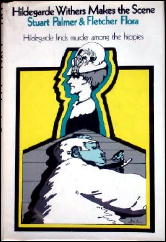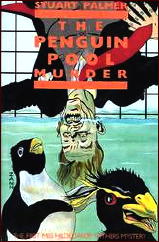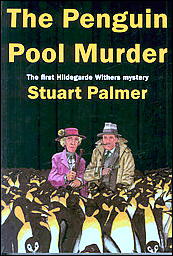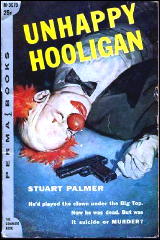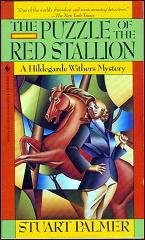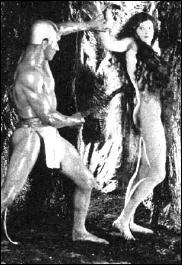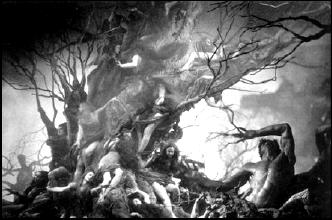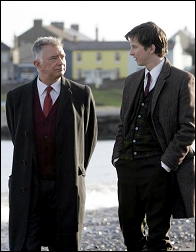Sun 9 Aug 2009
A Review by Mike Tooney: MARGERY ALLINGHAM – Mr Campion and Others.
Posted by Steve under Reviews[4] Comments
MARGERY ALLINGHAM — Mr Campion and Others. Penguin, paperback, 1950. Previously published in hardcover by William Heinemann (UK) with slightly differing contents. Reprinted many times.
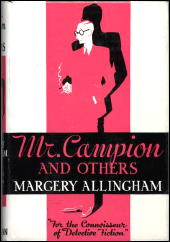
Some mystery authors have made their detectives as eccentric as possible (and sometimes beyond possibility) — Sherlock Holmes and Sir Henry Merrivale come immediately to mind — while other authors have gone entirely the other way, e.g., Father Brown. With Albert Campion, Margery Allingham seems deliberately to have created a character to rival Chesterton’s sleuth in the area of non-descriptness but still possessing exceptional intelligence.
Albert Campion seems amphibious, equally at home among the very rich and the riffraff; like Clark Kent he moves among the throng, always ready to hop into the nearest phone booth when an emergency arises.
His character is also comparable to certain fish species: Most of the time he is a remora, cruising with the sharks and on the lookout for whatever scraps of information or acquaintances that could prove useful in future enquiries; very seldom, he is himself a shark, when he must force a resolution to an issue of great personal or social importance. (In only one of the stories in this collection is he seen with a gun, and even then he doesn’t use it.)
To his many high society friends, he is instantly trustworthy; even a person who has just met him feels that way: “… a great many people do take you into their confidence, I believe?” To which he responds: “I’m as secret as the grave.”
Margery Allingham’s style, at least in these stories, is at or above average for the period (and considerably above average for today). She is literate without being literary, in the pejorative sense of that word.
In contrast with Mr. Campion, many of her minor characters are well described and memorable; her powers of description of places frequently find expression in some passages of what these days is referred to as “fine writing,” but they do not in any way impede the narrative flow — rather, they enhance the story by being relevant to the action.
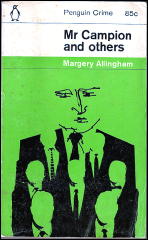
I. “The Widow” (The Strand, April 1937)
It begins: “The second prettiest girl in Mayfair was thanking Superintendent Stanislaus Oates for the recovery of her diamond bracelet and the ring with the square-cut emerald in it, and Mr. Campion, who had accompanied her to the ceremony, was admiring her technique.”
Funny how one thing can lead to another, isn’t it? First, Mr. Campion is using his refined palate to sample rare wines on behalf of his godson; then he is enlisted by Mr. Thistledown, a venerable vintner, to travel incognito to a “cold and sleepy village” on the Norfolk coast to watch “an experiment” being given by a man of “odd, Mephistophelean appearance.”
Next, after witnessing what must be a scientific miracle, Campion twigs on to a brilliant scam; and, in so doing, he also solves the subsidiary mystery of a newspaper ad seeking the services of a children’s entertainer.
In vino veritas, indeed! But there is one unresolved mystery: If Miss Peterhouse-Vaughn is the second prettiest girl in Mayfair, then who is the first?
II. “The Name on the Wrapper” (The Strand, March 1938; EQMM, November 1947)
It begins: “Mr. Albert Campion was one of those useful if at times exasperating people who remain interested in the world in general at three o’clock on a chilly winter’s morning. When he saw the overturned car, dark and unattended by the grass verge, therefore, he pulled up his own saloon and climbed out on to the road, whose frosty surface was glistening like a thousand diamonds.”
Returning home from a dinner party, Mr. Campion comes across the aforementioned automobile and a jewel-encrusted ring, not realizing he has encountered the aftermath of a major crime perpetrated among the very rich set. Superintendent Oates is on the case, and he calls for Campion; after all, he says, “You’re our Society expert.”
So, after some trolling among the haut monde, the “expert” snags a reluctant debutante whose appealing lack of guile eventually leads him to the thief, a Raffles wannabe with the skills, but not the good luck, to pull it off. The search is not without its rigors for Campion, however:
“He paused. The alarm had died out of her eyes and she even looked wanly amused. He was relieved. Idiotic conversation, although invaluable, was not a luxury which he often permitted himself now that the thirty-five-year-old landmark was passed.”
III. “The Hat Trick” (The Strand, October 1938; EQMM, January 1946 as “The Magic Hat”)
It begins: “Mr. Campion received the hat as a sentimental tribute. Mrs. Wynyard pressed it into his hand at her farewell party at the Braganza on the night before she sailed home to New York.”
Peter Herrick is gobsmacked with Prudence Burns, and she is inclined to reciprocate; but then there is Norman Whitman, whose influence with Prudence’s father is enormous and who is much too willing to serve as Mr. Burns’ entree into the glittering world of high society.
Furthermore, consider Mr. Campion’s silly little hat which, to his surprise, exercises an influence on Mr. Burns and restaurant waiters that is all out of proportion to its apparent charm. It isn’t long before Campion must admit: “… I’m afraid we’ve stumbled on the great forefather of all confidence tricks.”
IV. “The Question Mark” (The Strand, January 1938; EQMM, Fall 1941)
It begins: “When Miss Chloe Pleyell became engaged to Sir Matthew Pearing, K.C., Mr. Albert Campion crossed her name off his private list entitled ‘Elegant Young Persons Whom I Ought to Take to Lunch’ and wrote it in neatly at the foot of his ‘People I Must Send Christmas Cards to’ folder.”
Chloe Pleyell — “She was beautiful and she was charming and at heart a dear, he reflected, but unfortunately hardly safe out” — inadvertently creates something of a dust-up when she hires a “private enquiry agent” to “enquire” about her fiance; what he turns up could put somebody in prison, if the physical evidence is to be believed.
Mr. Campion comes to the rescue and nails a master thief (“The Question Mark”) when he sorts out “161” from “191.”
V. “The Old Man in the Window” (The Strand, October 1936)
It begins: “Newly appointed Superintendent Stanislaus Oates was by no means intoxicated, but he was cheerful, as became a man celebrating an important advance in a distinguished career, and Mr. Campion, who sat opposite him at the small table in the corner of the chop-house, surveyed the change in his usually taciturn friend with interest.”
Mr. Campion and the new superintendent are at dinner one evening and together witness the usual results of a love triangle, as Denise Warren breaks up with her fiance, Arthur March, when she arrives with Rupert Fielding, a young surgeon. Six weeks later a very senior member of Campion’s club, the Junior Greys, is found dead in his usual chair at that establishment.
Are the two events somehow related? Indeed, they are: “… where’s the crime?” asks Oates; “Well, it’s murder, you know,” replies Campion as they stand over the corpse. But more eyebrows than just Mr. Campion’s are raised when the victim decides to come back from the dead ….
VI. “The White Elephant” (The Strand, August 1936)
It begins: “Mr. Campion, piloting his companion through the crowded courtyard at Burlington House, became aware of the old lady in the Daimler, partly because her chauffeur almost ran over him and partly because she gave him a stare of such vigorous and personal disapproval that he felt she must either know him very well indeed or have mistaken him for someone else entirely.”
Chief Detective-Inspector Stanislaus Oates tells Campion, “Some society bit is mixed up in this somewhere, I’m sure of it.” The “society bit” to whom Oates ignorantly refers is Juliet Fysher-Sprigge, a good friend of Mr. Campion; “this” concerns a series of jewel robberies that the police are convinced were pulled off by The Sparrow, “a sleek, handsome chap with an insufferable manner.”
But surely Lady Florence, Dowager Countess of Marle, “the old lady in the Daimler,” also couldn’t be mixed up in a smuggling ring with her White Elephant Society charity, could she? Before this case is closed, Campion must not only decode the clue of common British Christian names but also survive a shoot out: “A bullet took Mr. Campion’s hat from his head … the darkness was streaked with fire ….”
VII. “The Frenchman’s Gloves” (The Strand July 1938; EQMM August 1947 as “The Case of the Frenchman’s Gloves”)
It begins: “Mr. Albert Campion was considering the hundred and fifteenth unintelligible oil painting under the muslin-shaded lights of the Excelsior Gallery’s stuffiest room, and wondered if it was honest reaction or merely age which made him yearn for an occasional pair of gluey-eyed, human-faced dogs by old Mr. Landseer. A pathetic sigh at his shoulder recalled him to his duty as a nursemaid. He glanced at Felicity apologetically.”
What if Shakespeare had had old Capulet, Juliet’s father, go missing at the end of Act I of his famous play? There is certainly friction between this Capulet (M. Edmond Gerard of Vaux, France) and these Montagues (the Roundels of Cornwall) when Madeleine Gerard and Henry Roundel express a desire to wed, so a conciliatory luncheon is arranged; but when the elder Gerard, a dealer in precious stones and a man renowned for his reclusiveness, checks into his London hotel, it’s virtually the last anyone sees of him — except, that is, for the visit he pays to a branch office to commune with some rubies…
Mr. Campion and Superintendent Oates smash a jewelry theft ring when Campion tumbles to the significance of one glove being dirty while the other is clean — and immeasurable assistance is provided by The Elephant with two legs.
VIII. “The Longer View” (The Strand, August 1938; EQMM, October 1946 as “The Crimson Letters”)
It begins: “On the day that the entrancing Beatrix Lea married her famous leading man, Mr. Albert Campion took Mr. Lance Feering to re-visit the happy scenes of Mr. Feering’s youth. The expedition was purely remedial.”
While nosing about an old flat that Lance Feering had lived in during his salad days, Lance and Mr. Campion come across something remarkable: inside a cupboard they find, in six-inch-high crimson letters, the words “O let me out let me out let me out let me out” and a name, “Janey”; Campion discovers that the writing was done in lipstick less than forty-eight hours previously.
It’s enough to start him on a trail that will ultimately lead to a gang of kidnappers and one “tough” little girl.
IX. “Safe as Houses” (The Strand , January 1940; EQMM, March 1944)
It begins: “Mr. Albert Campion came gingerly down the steep staircase of the White Lion Inn at Little Chittering in Sussex with two important queries occupying his mind. One was the comparatively simple question, where was the bar, and the other a more philosophical matter concerning the Blood Tie, or how much need the average man endure for his relations before he is entitled to sneak quietly home to London and go to earth in his club?”
For Mr. Campion it seems to be just a wild goose chase — no, make that a wild peacock chase. His formidable Great Aunt Charlotte is convinced that an interloper has invaded her sanctum, her drawing-room, and left unmistakable traces of his incursion: “There was the mark of a glass on my walnut lowboy,” she said at last, her voice dropping at the enormity of the crime. “An odious white ring; I saw it at once. Then there was the cigarette ash in the coal scuttle and of course the notepaper…” — notepaper inscribed with an address: “Grey Peacocks, Little Chittering.”
So here he is, one hundred and forty miles from home; but the locals have never heard of a house called the Grey Peacocks, and the investigation is going nowhere when Mr. Campion encounters “one of the prettiest girls he had ever seen in a long and by no means misspent youth” who is also looking for the same mythical residence — and isn’t that enough of a reason to revive Campion’s flagging interest in this seemingly trivial and tiresome mystery?
For not only is there more than meets the eye in it, but also considerably less.
X. “The Definite Article” (The Strand, October 1937; EQMM, November 1942)
It begins: “‘My dear man,’ said Old Lady Laradine, her remarkable voice penetrating the roar of the Bond Street traffic with easy mastery, ‘don’t you think you’re going to get away from me once I’ve settled down to a gossip. Come back here at once. Dorothea has got her girl safely engaged to Lord Petering, I see. You know him, don’t you? Tell me, do you approve?'”
Mr. Campion has scarcely evaded gossipy Old Lady Laradine when he falls into the clutches of Superintendent Oates. A young New York socialite has apparently committed suicide, and the American feds think her blackmailer — if indeed she was being blackmailed — could be in England.
“I’ll tell ’em I’ve put a Society expert on the job,” Oates said, grinning. “That’ll please ’em and keep ’em quiet for a bit. There you are. You came in here looking for something to do and now you’ve got it. There’s a little miracle for you. Pull that off.”
Oh, Campion pulls off the little miracle, all right; but first he must endure another harrowing encounter with Lady Laradine, divine the actions of a sinister psychometrist, and correctly explain the absence of one of the smallest words in the English language — the definite article.
XI. “The Meaning of the Act” (The Strand, September 1939; EQMM, May 1945)
It begins: “‘Trivial, vulgar, pettifogging, puerile, footling. At times even dirty,’ said Lance Feering, taking up his glass. ‘I don’t want to be hypercritical old boy, but that’s how I see this life of yours. It repels me. My stomach turns at it. I gag … You see what I mean?'”
“‘The light is filtering through,’ agreed Mr. Albert Campion affably, as he flattened himself against the ornate tiles behind him. ‘Criminology does not appeal to you tonight.'”
Marguerite Tiffin is concerned about her septuagenarian father, Dr. Clement Tiffin, “a distinguished bird, you know … a recluse, a famous man, an Egyptologist of world renown.” So when he starts “sneaking out of the house like an adolescent and trotting off to music halls alone, all up and down the country, performance after performance,” she could be forgiven for thinking that he’s at long last entered his dotage.
She prevails on her good friend Lance Feering, who in turn prevails on his good friend Mr. Campion. Soon the old professor is assaulted — but why would someone object so violently to an old guy ogling an exotic dancer doing her performance on a public stage?
Campion finally comes to understand why Dr. Tiffin’s name reminds him of crossword puzzles (it has to do with Room OB 40, naturally); paradoxically, Mr. Campion has far less difficulty understanding a man who says things like, “I caught a shice and did a carpet in the spring. Had to come to town without a coal. But a denar here and a denar there soon mounts up, you know, and I’m in clover. By the way, this is my monkery, so who’s your party?”
XII. “A Matter of Form” (The Strand , May 1940; EQMM, January 1945)
It begins: “‘The trouble with crime to-day,’ remarked Superintendent Stanislaus Oates seriously, ‘is that one almost gets too much of it, if you see what I mean.’
“‘Absolutely,’ murmured his companion with solemn, not to say owlish, gravity. ‘The word you’re searching for is “common,” isn’t it?'”
Brian Green is enamored of Miss Susan Chad; Susan, in turn, is enamored of brains — something, poor child, she seems bereft of. Small wonder she becomes the victim of a criminal who, in Mr. Campion’s words, has “more brains than average”, a thief who, with a little more self-control and energy, could prove unstoppable — but the frog who would a-wooing go should really beware of the fine fat duck with a set of handcuffs ….
XIII. “The Danger Point” (The Strand, June 1937; EQMM, May 1948)
It begins: “Mr. Albert Campion glanced round the dinner table with the very fashionable if somewhat disconcerting mirror top and wondering vaguely why he had been asked, and afterwards, a little wistfully, why he had come.”
Mr. Campion attends a posh dinner party attended by the brother of an old friend, Geoffrey Painter-Dell; by a young lady Geoffrey has warm feelings for, Petronella Andrews; and Leo Seazon, who “was a natural intriguer and had a finger in every pie.”
At the time, Campion doesn’t recognize what Petronella has hung around her neck: an elegant pearl necklace that had been stolen seven years ago from Geoffrey’s current employer, Lady (Cinderella) Lamartine. The fact that Petronella is in possession of stolen property could result in ruinous scandal for the two young lovers, something that isn’t lost on the treacherous Leo Seazon.
To further complicate matters, the necklace is stolen yet again; it’s up to Mr. Campion to quash the whole unwholesome affair before Cinderella gets on the ball.
